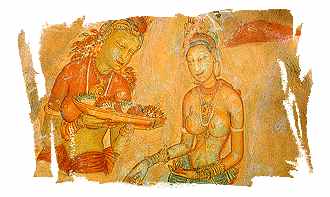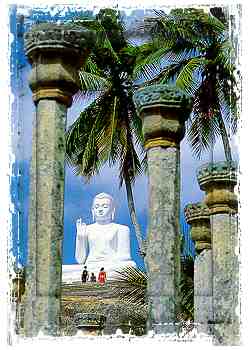|
|
From time immemorial the island has been subjected to many different influences, both occidental and oriental. Consequently this small island state contains an exotic mixture of languages, cultures and religions. The few thousand Veddhas who live in remote jungle areas are the descendants of the original inhabitants. The majority of the population are descendants of the Aryan tribes that came from North India over 2'000 years ago. Sub sequent Dravidian invasions and Arab migrations have created a wonderful cosmopolitan society. The island has been known by
a variety of names, a list which is as varied as its historical influences.
More than 2000 years ago the famous Indian epic "Ramayana" told of misdeeds
of the wicked king of Lanka. The Dravids called the isle Ilankai; to the
old Greeks and the Romans it was known as Taprobane; the Arabic merchants
called it Serendib; the Portuguese Ceiloa; the Dutch changed the name into
Ceylan, and the British to Ceylon. The Republic of Sri Lanka was born in
1972, the prefix "Sri" is Sanskrit in origin and means resplendent.
The British, who ruled the island from 1795 - 1948 have exerted the most lasting influences on the country and its people. The Portuguese (1505 - 1658) and the Dutch (1658 - 1795) were only able to control the coastal areas. The Portuguese were as interested in saving souls as they were interested in trade. Their evangelical mission has had a lasting influence, and they gave many Sri Lankans their names: Fernando, Silva, Perera, Alfonso, and many more. The Dutchmen were more interested in trade and less about the salvation of the natives. They have built an imposing canal system along with many fortifications for the protection of the merchants and water ways. In 1796 the English expelled the Dutch out of Ceylan as it was called at that time. Then they conquered the interior of the island, took the last Singhalese king in Kandy captive and abducted him to India into exile, where later he died. In the highlands coffee plantations were laid out. By 1870 Ceylon was the most important coffee cultivation area of the British empire, when a disastrous fungus infested and destroyed the bulk of the coffee plants. In 1867 the first tea plants arrived from India, and prospered extremely well in the highlands. As a result the more resistant tea bushes replaced the susceptible coffee cultures. For more than a century tea became the most important export product. Ceylon Tea is today well known by tea-connoisseurs and tea-lovers, and in 1972 this persuaded the government, to retain the brand name "Ceylon Tea" and not to market it as "Sri Lanka Tea". What have the English brought, and what was left in 1948 when Ceylon regained her in dependence? The coffee cultivation which today covers hardly more than a quarter of the domestic demand. The tea cultivation and the tea drinking. The Tamil problem through their politics of "divide and reign," in actively supporting the Tamil minority. Before attaining independence in 1948 the large majority of the government employees in the colonial offices and university graduates were Tamils, with less than 12% of the total population. After independence these special privileges were abolished by the ruling majority of Sing- halese, which was resented by the Tamil population as a form of suppression, with all its political consequences. Then the legal system is based on the English common law. Traffic rules require left-hand driving, however sometime this is difficult to see on the road as hardly anybody keeps the traffic rules. Although English Has been abolished in school as a major subject many years ago, all middle-class and upper-class families speak English amongst themselves; Singhalese or Tamil is only spoken with the domestic employees and people of the lower castes who do not understand English. There are even Sri Lankans born after independence who only speak English and not Singalese or Tamil. In innumerable member-only clubs, gin and tonic, whisky and soda, and also warm beer is served. All clubs have dress codes along with rules of behaviour. Collarless T-shirts, shorts and open slippers are not acceptable. The most popular sport here is cricket; a game, that can last for days and days and is often very boring. The English also brought their own culinary traditions; however, today the Sri Lankans prefer the continental European kitchen or local and Asian specialties to English food. Everybody speaks of the Queen, and they mean the Queen of England. Royal College is the top school for the elite of the country, and also The Royal Colombo Golf Club has not changed its name after independence. Both institutions are proud for their "Royal" connection which was granted to them by royal decree more than hundred years ago. Ceylon has always been typically English and even for Sri Lanka today this statement is still valid. 6th Cent. BC. Colonisation by the Aryan people of Singha (Lions), which under the leadership of Prince Vijaya arrived from North-India. Vijaya is the progenitor of all the 180 Singhalese kings who have ruled the country with very few interruptions for 2'300 years. The last king of this dynasty died in the middle of the 18th Century.
The island of Sri Lanka, the "pearl of the tropics," has a surface area of about 66'000 km2. It is situated slightly north of equator off the southeast tip of the Indian sub continent and separated from South-India by a very narrow waterway, known as the Palk Strait. The distance from north to south is 435 km and from west to east at the widest point 225 km. As Sri Lanka is situated between six and ten degrees north of the equator, the average temperature is quite high. The average medium temperature fluctuates between 27� and 29� C. As the island is not very wide, the sea-winds can exert a moderating influence. The central mountain region has naturally lower temperatures. The mercury drops �� C. for every 100 m. The mountain resort town of Nuwara Eliya situated at about 2000 m experiences frost on some nights in December and January and the annual average temperature is below 20� C. In general the relative humidity fluctuates in between 70% for the day and 90% at night. The monsoon-winds bring the most showers to Sri Lanka; there are four rainy periods:
Sri Lanka has a population of approximately 17 millions, a yearly growth rate of 1.3% and a population-density of 275 persons per km2. The life expectancy is for men 67 years and for women 72 years. The population consists of the following ethnic groups: Singhalese 74%, Tamils of 18%, Moors of 7% and others 1%. From the religious point of view the population consists of 69% Buddhists (Singhalese), 15% Hindu (Tamils), 8% Moslems (Moors), 7% Christians and 1% others. The two official languages are Singhalese and Tamil, however English is spoken almost everywhere; even in the most remote areas someone always speaks English. When attaining independence (in 1948) Ceylon was a pure agrarian country. Only during the last decade has industrial development grown at an accelerated pace. The majority of foreign exchange income results from textile exports, export of agricultural products (tea, copra, rubber), the revenue from tourism and the exports of jewellery and gems. At independence Ceylon followed the British system of government and the head of the government was the prime minister. With the reform of the constitution in 1978 a presidential system was adopted and as in France all executive powers were invested in the president who chooses his cabinet of ministers. The country is divided into provinces, which until a few years ago were centrally governed. With the introduction of a federal system the provinces have their own assemblies and government. Presidential elections take place every seven years by the whole electorate All citizen over 18 years of age have the right to vote. Sri Lanka's official name is: Democratic Socialist Republic of Sri Lanka. The capital and seat of the central government and parliament is no longer Colombo but Sri Jayawardenapura, earlier called Kotte, a small town at the outskirts of the former capital city Colombo. The Sri Lanka Rupee (SLRs) is divided into 100 cents. Coins are minted into domination of 5, 10, 25 and 50 cents and 1, 2, 5 and 10 rupees. There are notes of 10, 20, 50, 100, 500 100o and 2000 rupees. 110 rupees are equal to about US $ 1.00. There might be no other country in the world with so many holidays as in Sri Lanka. In addition to all the Sundays all important Christian, Moslem and Hindu festivals and all Buddhist and national festivals are celebrated. Every full moon day, called Poya, is a Buddhist holiday. On a Poya all places of entertainment as well as all the bars remain closed, and the sale of alcohol is prohibited! Including Sundays, Sri Lanka has about 72 holidays per year. The local eating habits are dominated by curries, which, beside international dishes, are, in a milder form, regularly served by almost all the hotels to foreign visitors. In Colombo there is a wide choice of specialty restaurants, where Chinese, Japanese, Korean, Indian, Lebanese, Thai, French, Italian, German and Swiss food is available. Some of these restaurants are located in the first-class hotels. The prices for food and beverage in the local restaurants are still very reasonable. In the first-class hotels in Colombo and on the beaches etc., however much higher prices will be charged. For imported (alcoholic) beverages prices in bars and restaurants are similar to those in continental Europe. |

 Sri Lanka
Sri Lanka
